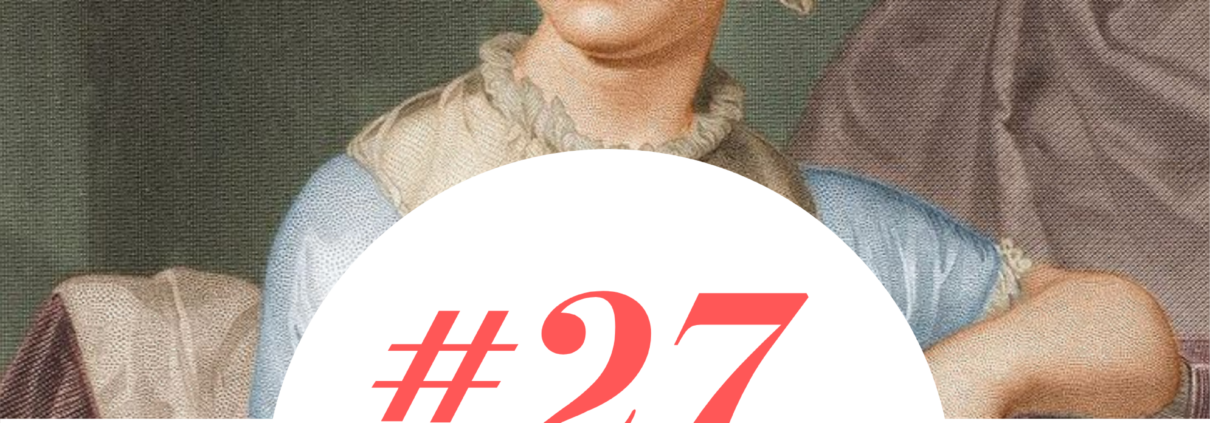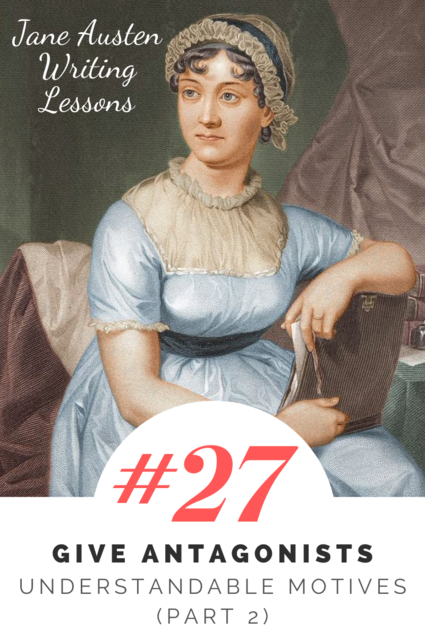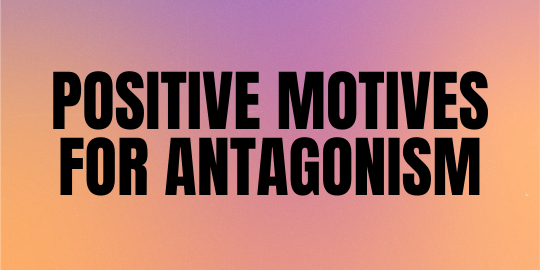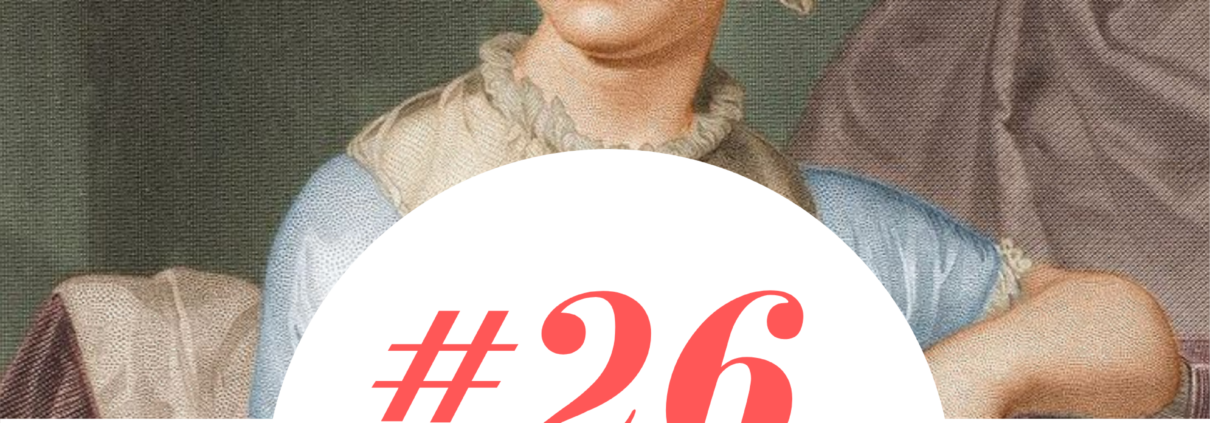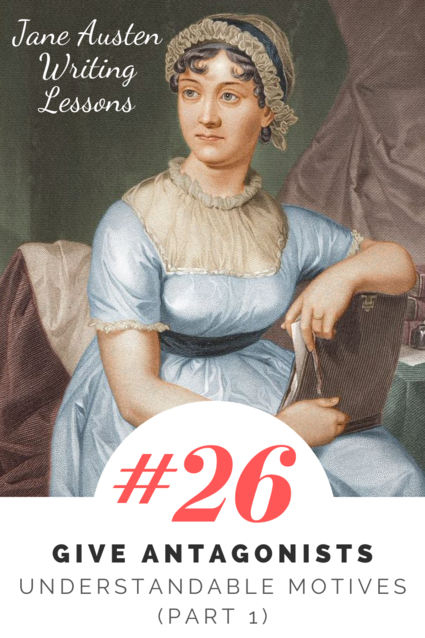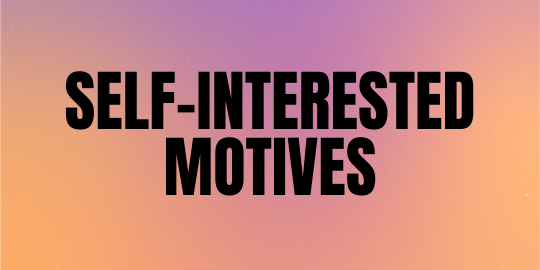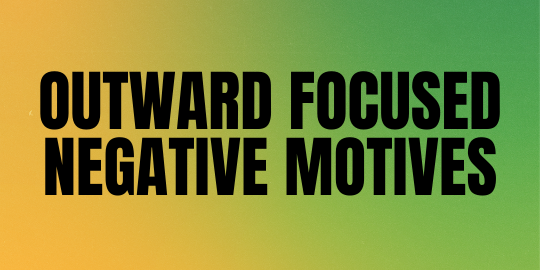#27: Give Antagonists Understandable Motives (Part 2)
Jane Austen’s antagonists are some of her most memorable characters—full of depth, complexity, and nuance, and continuously getting in the way of protagonists.
In the last lesson, Give Antagonists Understandable Motives (Part 1), I addressed negative motives for antagonism, like selfishness, a disregard for social norms, spite, cruelty, and revenge.
Yet not every antagonist interferes with the protagonist for negative reasons. Plenty of antagonists have positive or neutral motives for their interference. And these sorts of motives will be the focus of this lesson.
Positive Motives for Antagonism
Sometimes good people, trying to do good things, unintentionally make life more difficult for others.
Positive motives can be antagonistic when:
In Sense and Sensibility, there are a number of people who attempt to do good for the Dashwood family, yet are sometimes unintentionally antagonistic.
Sir John Middleton has offered his cottage to the Dashwoods because of their lack of their home, which is very generous of him, but also creates a lot of obligation for Mrs. Dashwood, Marianne, and Elinor.
Marianne especially finds Sir John antagonistic toward her goals, as well his wife, Lady Middleton, and her mother Mrs. Jennings and sister Mrs. Palmer. They are constantly interfering with Marianne’s sense of self, her need for independence and solitude, and her desires for certain types of company. They also are trying to matchmake a relationship between Marianne and Colonel Brandon, and they do this out of good motives—they seem like they would make a good match, and it would give Marianne a very advantageous marriage and help her out of poverty. But that’s not what Marianne wants.
Elinor finds the Middletons less antagonistic than Marianne does, yet sometimes their teasing and their mannerisms do make her uncomfortable and act in opposition to her journey.
Another example of an antagonistic character in Sense and Sensibility is Mrs. Dashwood herself. At the beginning of the novel, she does not want to economize, which makes finding their family a home very difficult. She also overprioritizes her love for Marianne, to the point where she refuses to act as a parent figure and talk to Marianne about the pitfalls of her behavior. She’s so afraid with damaging their relationship that she won’t even ask Marianne if she is engaged, and rather than helping Marianne, this contributes to Marianne’s difficulties (and also to Elinor’s). To me, she is one of the most interesting characters, because she is likeable and good and yet so very flawed in her behavior.
Neutral Motives for Antagonism
While a lot of antagonistic motives are clearly either negative or positive, some motives are more neutral.
A few types of neutral motives that can be antagonistic:
A sometimes-antagonistic character who has neutral motives is Edward Ferrars. Elinor falls in love with Edward, and while at Norwood Park he seems to return her affections. But when Elinor, her sisters, and her mother move, he becomes entirely absent from her life, which causes a lot of angst and sadness for Elinor. He eventually visits, but the visit is a rather uncomfortable one.
It turns out that several years before Edward became secretly engaged to Lucy Steele. Because he is a man of his word and trying to do the right thing, he won’t break off his engagement to Lucy, because that would hurt her and break his word. Yet in being honorable to Lucy, he is breaking Elinor’s heart, and giving his attentions to Elinor in the first place wasn’t very fair, knowing that he did not intend to act.
Neutral motives that create antagonism are some of the most interesting to explore in literature because they cause so much tension and they allow writers to explore the nuances and complexities of relationship and morality.
In Conclusion
Story is about conflict, it’s about a character on a journey interrupted, a journey that has challenges, many of them caused by other characters. As a protagonist goes about their journey, they face antagonism not just from Antagonists—people that are actively and intentionally opposing the core journey—but also from characters, large and small, who might be friends, family members, or acquaintances. Considering the full range of motives for antagonism can help you write more complex and interesting stories.
Next lesson we’ll focus on one final antagonist in Sense and Sensibility, my favorite Jane Austen bad-guy, John Willoughby. He has positive motives, he has negative motives, and he has neutral motives. Ultimately Jane Austen treats him with a certain kindness, allowing him some level of redemption, by giving him a chance to tell his story.
Exercise 1:
Think about someone in your life—currently, or in the past—who has good motives, and yet makes your life more difficult or negatively interferes in certain areas of your life. Write several paragraphs about this person and their behavior. Make sure to examine specific actions they take (whether physical actions, dialogue, text, etc.) that act antagonistically in your life, and record also your reaction to these actions in the moment and over time.
Exercise 2:
Write several paragraphs from the viewpoint of an antagonist who is forced to choose between two competing principles:
- Telling the truth; being sensitive to the feelings of others
- Being on time; being prepared
- Helping someone else; taking care of your own basic needs
- Saving for the future; enjoying the moment
- Another pair of competing principles you create
After they make the choice between the principles, have the character experience both positive and negative consequences as a result of their choice.
Exercise 3: A No Good, Very Bad Day
Set a timer for 5 or 10 minutes and do a rush write about a character, in which everything they do over the course of the day has negative or unforeseen consequences for other people.

